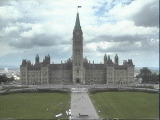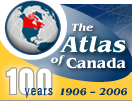| The public-administration map shows the specialization
in employment for the federal, provincial and municipal governments,
and for the aggregate of the three public-administration sectors.
The employment in public administration is primarily important for
the economic impact of government jobs on local communities. Public
administration favours the capital cities; however, in recent years,
the increasing employment in education and health services has identified
urban centres based on the location of universities or regional
health-care facilities.
 [D] [D]
Click for more information, 14 KB
Photograph of Parliament Buildings, Ottawa, Ontario
Geographical Description
This map consists of four thematic map layers that show public-administration
specialization in terms of overall public-administration activity
(initial map view) and individual specialization in federal, provincial
and municipal activities. On all map layers, the size of the circles
is proportional to the population of the cities, while the degree
of specialization is shown by the colour.
In general, the industrial cities of southern Ontario and Quebec
are less favoured. Many of the disadvantaged locations are the same
cities that lose out in the private sector: those places that lie
in the shadow of larger cities. Large cities typically have values
close to zero because of their diversity. Rural and urban differences
in public administration are very strong. In the Prairie provinces,
for example, the smaller rural cities, which are located farther
away from the larger Prairie cities, serve a wider rural community.
There are also major variations within the urban areas that surround
the larger consolidated metropolitan regions such as Toronto and
Montréal: some specialize in public services, while others
are largely residential.
Clusters of federal-government centres have developed in and around
Ottawa (for example, Hull, Quebec; Kanata, Ontario) and at locations
with large military bases (for example, Victoria, British Columbia;
Grand Centre, Alberta; Halifax, Nova Scotia). Federal-government
specialization is also proportionally high in provincial and territorial
capitals. Provincial-government specialization is highest in the
provincial capitals and in resource-based centres (for example,
Kenora, Ontario; Thompson, Manitoba), which tend to serve as regional
centres in the more outlying areas of their provinces. Municipal
specialization is sensitive to income level (ability to pay), with
some of the highest values occurring in the wealthier urban centres
surrounding Toronto (for example, Halton Hills and Georgina) and
Montréal (for example, Varennes and Beloeil), where urban
centres with higher incomes can support more services. Rural and
urban differences in municipal government activity are very strong,
since smaller and dispersed populations (as found in rural areas)
simply do not support as many services as urban places.
To properly interpret this map, please consult the text Data
and Mapping Notes.
|
